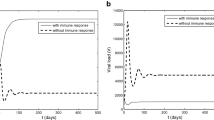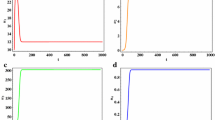Abstract
The purpose of this study was to investigate strategies in the monotherapy treatment of HIV infection in the presence of drug-resistant (mutant) strains. A mathematical system is developed to model resistance in HIV chemotherapy. It includes the key players in the immune response to HIV infection: virus and both uninfected CD4+ and infected CD4+ T-cell populations. We model the latent and progressive stages of the disease, and then introduce monotherapy treatment. The model is a system of differential equations describing the interaction of two distinct classes of HIV—drug-sensitive (wild type) and drug-resistant (mutant)—with lymphocytes in the peripheral blood. We then introduce chemotherapy effects. In the absence of treatment, the model produces the three types of qualitative clinical behavior—anuninfected steady state, andinfected steady state (latency), andprogression to AIDS. Simulation of treatment is provided for monotherapy, during theprogression to AIDS state, in the consideration of resistance effects. Treatment benefit is based on an increase or retention in CD4+ T-cell counts together with a low viral titer. We explore the following treatment approaches: an antiviral drug which reduces viral infectivity that is administered early—when the CD4+ T-cell count is ≥300/mm3, and late—when the CD4+ T-cell count is less than 300/mm3. We compare all results with data. When treatment is initiated during the progression to AIDS state, treatment prevents T-cell collapse, but gradually loses effectiveness due to drug resistance. We hypothesize that it is the careful balance of mutant and wild-type HIV strains which provides the greatest prolonged benefit from treatment. This is best achieved when treatment is initiated when the CD4+ T-cell counts are greater than 250/mm3, but less than 400/mm3 in this model (i.e. not too early, not too late). These results are supported by clinical data. The work is novel in that it is the first model to accurately simultate data before, during and after monotherapy treatment. Our model also provides insight into recent clinical results, as well as suggests plausible guidelines for clinical testing in the monotherapy of HIV infection.
Similar content being viewed by others
References
Coffin, J. M. 1995. HIV population dynamics in vivo: implications for genetic variation, pathogenesis and therapy.Science 267, 483–489.
Concorde Coordinating Committee. 1994. MRC/ANRS randomized double-blind controlled trial of immediate and deferred AZT in symptom-free HIV infection.The Lancet 343, 871–881.
Embretson, J.et al. 1993. Analysis of HIV infected tissues by amplification andin situ hybridization reveals latent and permissive infections at single-cell resolution.Proc. Nat. Acad. Sci. 90, 357.
Fischl, M. A.et al. 1990. The safety and efficacy of AZT in the treatment of subjects with mildly symptomatic HIV type 1.Annals Int. Med. 112, 727–737.
Hamilton, J. D.et al. 1992. A controlled trial of early vs. late treatment with AZT in symptomatic HIV infection.New England J. Med. 326, 437–443.
Ho, D. D.et al. 1995. Rapid turnover of plasma virions and CD4 lymphocytes in HIV-1 infection.Nature 373, 123–126.
Kirschner, D. and A. Perelson. 1995. A model for the immune system response to HIV: AZT treatment studies. InMathematical Populations Dynamics III, Theory of Epidemics, O. Arino, D. Axrlrod and M. Kimmel (Eds), Vol. 1, pp. 295–310. Winnepeg, Man., Canada: Wuerz.
Kirschner, D. and G. F. Webb. 1996. A model for treatment strategy in the chemotherapy of AIDS.Bull. Math. Biol. 58, 367–391.
Kirschner, D. and G. F. Webb. 1997a. A mathematical model of combined drug therapy of HIV infection.J. Theoret. Med., to appear.
Kirschner, D. and G. F. Webb. 1997b. Qualitative differences in HIV chemotherapy between resistance and remission outcomes.Emerging Infect. Dis., to appear.
Lafeuillade, A., C. Poggi, N. Profizi,et al. 1996. Human immunodeficiency virus type 1 in lymph nodes compared with plasma.J. Infect. Dis. 174, 404–407.
Larder, B. A.et al. 1989. HIV with reduced sensitivity to zidovudine (AZT) isolate during prolonged therapy.Science 243, 1731–1734.
Lovy, J. A., J. Guthrie and T. Elbeik. 1996. Plasma viral load, CD4+ cell counts, and HIV-1 production in cells.Science 271, 670–671.
Loveday, C.et al. 1995. HIV-1 RNA serum-load and resistant viral genotypes during early zidovudine therapy.LANCET 345, 820–824.
McLean, A. and M. Nowak. 1992. Competition between AZT sensitive and AZT resistant strains of HIV.AIDS 6, 71–79.
McLean, A.et al. 1991. Population dynamics of HIV within an individual after treatment with AZT.AIDS 5, 485–489.
McLean, A. R. and M. A. Nowak. 1992. Competition between zidovudine-sensitive and zidovudine-resistant strains of HIV.AIDS 6, 71–79.
McLeod, G. X. and S. M. Hammer. 1992. Zidovudine: 5 years later.Annals Int. Med. 117, 487–501.
Mohri, H.et al. 1993. Quantitation of zidovudine-resistant human immunodeficiency virus type 1 in the blood of treated and untreated patients.Proc. Nat. Acad. Sci. USA 90, 25–29.
Pantaleo, G., C. Graziosiet al. 1996. HIV infection is active and pregressive in lymphoid tissue during the clinically latent stage of disease.Nature 362, 355–358.
Perelson, A.et al. 1996. HIV-1 dynamics in vivo: clearance rate, infected cell lifespan, and viral generation time.Science 271, 1582–1585.
Perelson, A.et al. 1993. The dynamics of HIV infection of CD4+ T cells.Math. Biosci. 114, 81–125.
Perelson, A. S. 1989. Modeling the interaction of the immune system with HIV. InMathematical and Statistical Approaches to AIDS Epidemiology, Lect. Notes in Biomath.. C. Castillo-Chavez (Ed), Vol.83, pp. 350–370. New York: Springer-Verlag.
Redfield, R. and D. Burke. 1988. HIV infection: the clinical picture.Sci. Amer. 90–98.
Richman, D. D.et al. 1990. Effect of stage of disease and drug dose on zidovudine susceptibilities of isolates of human immunodeficiency virus.J. Acquired Immune Deficiency Syndromes 3, 743–746.
Ruffault, A.et al. 1995. The prognostic value of plasma viremia in HIV-infected patients under AXT treatment—a two-year follow-up study.J AIDS 9, 43–248.
Vella, S.et al. 1994. Long-term follow up of AZT therapy in asymptomatic HIV infection: results of a multicenter cohort study.J. AIDS 7, 31–38.
Volberding, P. A.et al. 1994. The duration of zidovudine benefit in persons with asymptomatic HIV infection.J. Amer. Med. Assoc. 272, 437–442.
Volberding, P. A.et al. 1990. Zidvudine in asymptomatic human immunodeficiency virus infection.New England J. Med. 322, 941–949.
Wei, X.et al. 1995. Viral dynamics in human immunodeficiency virus type 1 infection.Nature 373, 117–122.
Author information
Authors and Affiliations
Rights and permissions
About this article
Cite this article
Kirschner, D.E., Webb, G.F. Understanding drug resistance for monotherapy treatment of HIV infection. Bltn Mathcal Biology 59, 763–785 (1997). https://doi.org/10.1007/BF02458429
Received:
Accepted:
Issue Date:
DOI: https://doi.org/10.1007/BF02458429




